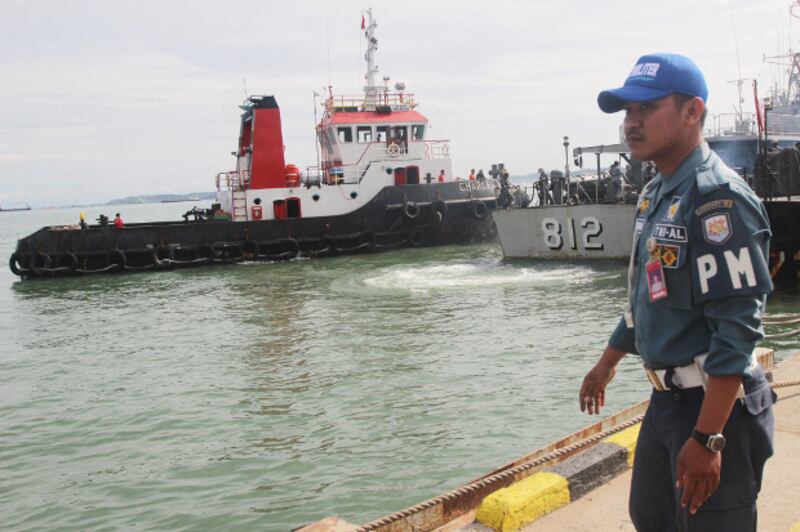On that sweltering afternoon, June 20, 2016, Tugboat Charles 001 was sailing at normal speed in the waters between Jolo and Tawi Tawi in the southern Philippines, pulling the barge Robby 152 after making a coal delivery at Cagayan De Oro, Philippines.
Indonesian sailor Rudi Kurniawan was at the helm, keeping an eye on the tugboat’s coordinates and speed. Three crew members were with him in the wheelhouse.
“It was almost time for a crew change. I was tired after being at the helm all day,” Rudi told BenarNews in Balikpapan, East Kalimantan, on June 26.
His sleepiness vanished when two speedboats pulled up on either side of the tugboat and a dozen men pointed rifles in their direction.
“It crossed my mind, they are Abu Sayyaf. There’s been piracy before in the waters off Tawi-Tawi,” he said. Fourteen Indonesian sailors were snatched in two separate incidents in March and April, then released in May after being held by Abu Sayyaf, a group known for taking foreigners hostage and killing some of their captives.
Rudi and his three colleagues rounded up the nine other crew members, and all of them crowded into the wheelhouse. Meanwhile, armed men were getting on board.
“Some of them had already gotten on the boat, pointing their guns at us. We couldn’t do anything but put our hands up in a sign of surrender,” said Rudi, who still appeared exhausted.
‘Where are the engineers?’
By Rudi’s count, seven pirates boarded the tugboat. One of them, using a Malay dialect, began asking for the tugboat’s engineers. They tied up the tugboat captain Ferry Arifin, chief engineer Muh Mahbrur Dahri and engineer Edi Suryono.
“They were looking for machinists. ‘Where are the engineers, where are the engineers!’” said Andi Wahyu, another crew member, imitating the pirates.
“Edi’s hands were immediately tied with rope. Then they grabbed Ferry and Mahbrur, pointing their guns at them.”
The three were loaded onto a speedboat, along with most of the tugboat’s communications equipment.
One of the sailors started crying as the three most senior members of the crew were led away.
“Seeing our mate cry, the pirate who spoke Malay said we didn’t need to worry because they are only after money from the owner of our boat,” Andi said.
In Jakarta on Monday, Indonesian Armed Forces chief Gen. Gatot Nurmantyo told reporters that the kidnappers had demanded a ransom of 200 million Philippine pesos, the equivalent of almost 65 billion Indonesian rupiah (U.S. $4.9 million).
He said the hostages were likely being held on Jolo, in the Sulu archipelago of the southern Philippines. Authorities believe two different groups are behind the snatchings, one of them led by Abu Sayyaf figure Al Habsyi Misaya.
“The other one we don’t know yet, and we’re looking into it,” Gatot said, adding that Indonesia’s government was in close contact with counterparts in the Philippines.

A navy police officer stands on the dock as Tugboat TB Charles 001 pulls in to Semayang Port in Balikpapan, East Kalimantan, June 25, 2016. (Gunawan/BeritaBenar)
Second attack
As soon as the pirates took off, the remaining crew set a rapid course away from Jolo, while trying to get a signal on a cell phone a crew member had managed to hide from the hijackers, Andi said.
“Our panic had not even subsided, we had just started up again, when another speedboat with armed men appeared,” he said.
The crew tried to outrun this boat, abandoning the barge to increase their speed.
“We weren’t as fast as them even after we let the barge go. In the end the armed men boarded the boat,” Andi said.
The second group, wearing brown camouflage uniforms and bullet-proof vests, looked even more terrifying than the first.
With no senior crew left to snatch, this group tied up four members of the crew.
“Without saying too much, they took our four crew mates,” Andi recounted.
Deeply shaken, the six remaining sailors started their journey once again, heading for Kalimantan.
“For 35 hours, we took turns driving the boat out of Jolo waters until we reached Berau [Kalimantan] and immediately called the [shipping] company on the remaining cell phone,” Andi said.
Indonesia had announced a moratorium on coal shipments to the Philippines after the earlier kidnappings, but shipping companies did not comply.
Plans by Indonesia, Malaysia and the Philippines to mount joint patrols in waters along their shared borders to prevent more maritime hijackings have not yet materialized.
The release of the 14 sailors in May was secured through diplomatic efforts and not ransom payments, Indonesian Foreign Minister Retno Marsudi said at the time.
Malaysia acknowledged that 12 million ringgit (U.S. $2.94 million) was paid to unnamed organizations in the Philippines to obtain the release earlier this month of four Malaysian sailors kidnapped in April. But the money was not ransom paid to Abu Sayyaf, Deputy Prime Minister Adhamd Zahid Hamidi said.
